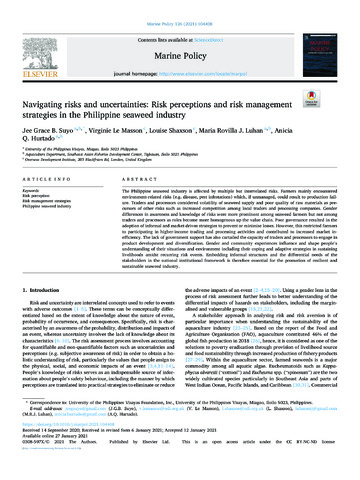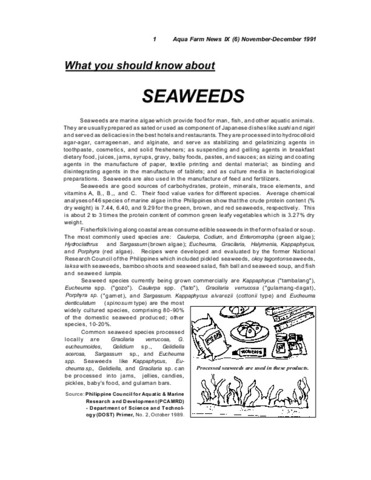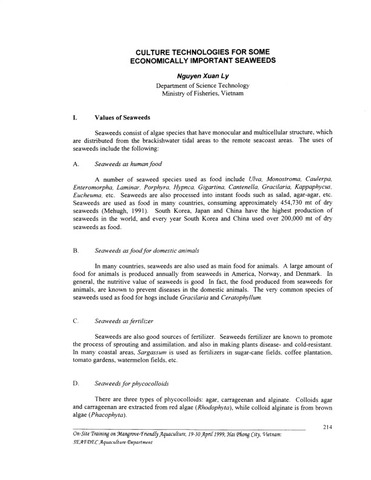Biosecurity policy and legislation for the global seaweed aquaculture industry
Share
| dc.contributor.author | Campbell, Iona | |
| dc.contributor.author | Kambey, Cicilia S. B. | |
| dc.contributor.author | Mateo, Jonalyn P. | |
| dc.contributor.author | Rusekwa, Sadock B. | |
| dc.contributor.author | Hurtado, Anicia Q. | |
| dc.contributor.author | Msuya, Flower E. | |
| dc.contributor.author | Stentiford, Grant D. | |
| dc.contributor.author | Cottier-Cook, Elizabeth J. | |
| dc.date.accessioned | 2020-01-07T07:13:38Z | |
| dc.date.available | 2020-01-07T07:13:38Z | |
| dc.date.issued | 2020-08 | |
| dc.identifier.citation | Campbell, I., Kambey, C. S. B., Mateo, J. P., Rusekwa, S. B., Hurtado, A. Q., Msuya, F. E., Stentiford, G. D., & Cottier-Cook, E. J. (2019). Biosecurity policy and legislation for the global seaweed aquaculture industry. Journal of Applied Phycology. https://doi.org/10.1007/s10811-019-02010-5 | en |
| dc.identifier.issn | 0921-8971 | |
| dc.identifier.uri | http://hdl.handle.net/10862/3568 | |
| dc.description.abstract | Each year a significant proportion of global food production is lost to pests and diseases, with concerted efforts by government and industry focussed on application of effective biosecurity policies which attempt to minimise their emergence and spread. In aquaculture the volume of seaweeds produced is second only to farmed fish and red algal carrageenophytes currently represent approximately 42% of global production of all seaweeds. Despite this importance, expansion of the seaweed sector is increasingly limited by the high prevalence of recalcitrant diseases and epiphytic pests with potential to emerge and with the demonstrated propensity to spread, particularly in the absence of effective national and international biosecurity policies. Developing biosecurity policy and legislation to manage biosecurity risk in seaweed aquaculture is urgently required to limit these impacts. To understand current international biosecurity frameworks and their efficacy, existing legislative frameworks were analysed quantitatively for the content of biosecurity measures, applicability to the seaweed industry, and inclusion of risks posed by diseases, pests and non-native species. Deficiencies in existing frameworks included the following: inconsistent terminology for inclusion of cultivated seaweeds, unclear designation of implementation responsibility, insufficient evidence-based information and limited alignment of biosecurity hazards and risks. Given the global importance of the cultivation of various seaweeds in alleviating poverty in low and middle income countries, it is crucial that the relatively low-unit value of the industry (i.e. as compared with other aquatic animal sectors) should not conflate with a perceived low risk of disease or pest transfer, nor the subsequent economic and environmental impact that disease transfer may impact on receiving nations (well beyond their seaweed operations). Developing a clear basis for development of robust international biosecurity policies related to the trade in seaweeds arising from the global aquaculture industry, by first addressing the gaps highlighted in this study, will be crucial in limiting impacts of pests and diseases on this valuable industry and on natural capital in locations where seaweeds are farmed. | en |
| dc.publisher | Springer Verlag | en |
| dc.relation.uri | https://link.springer.com/content/pdf/10.1007/s10811-019-02010-5.pdf | |
| dc.rights.uri | http://creativecommons.org/licenses/by/4.0/ | |
| dc.subject | ASEAN | en |
| dc.title | Biosecurity policy and legislation for the global seaweed aquaculture industry | en |
| dc.type | Article | en |
| dc.citation.volume | 32 | en |
| dc.citation.spage | 2133 | en |
| dc.citation.epage | 2146 | en |
| dc.citation.journalTitle | Journal of Applied Phycology | en |
| dc.subject.asfa | seaweed culture | en |
| dc.subject.asfa | seaweeds | en |
| dc.subject.asfa | trade | en |
| dc.subject.asfa | globalization | en |
| dc.subject.asfa | legislation | en |
| dc.subject.asfa | policies | en |
| dc.identifier.essn | 1573-5176 | |
| dc.identifier.doi | 10.1007/s10811-019-02010-5 |
Files in this item
| Files | ขนาด | รูป | View |
|---|
รายการนี้ปรากฏใน (s)
-
AQD Journal Articles [1215]
These papers were contributed by AQD staff to various national and international journals




